Iceland in March Winter Hiking and Northern Lights (Tips and Trip Report)
Winter in Iceland is the coldest, longest, and darkest season, yet it’s a great season to catch the northern lights and do some winter hiking, especially in March.
All while having the chance to see Iceland covered in snow.
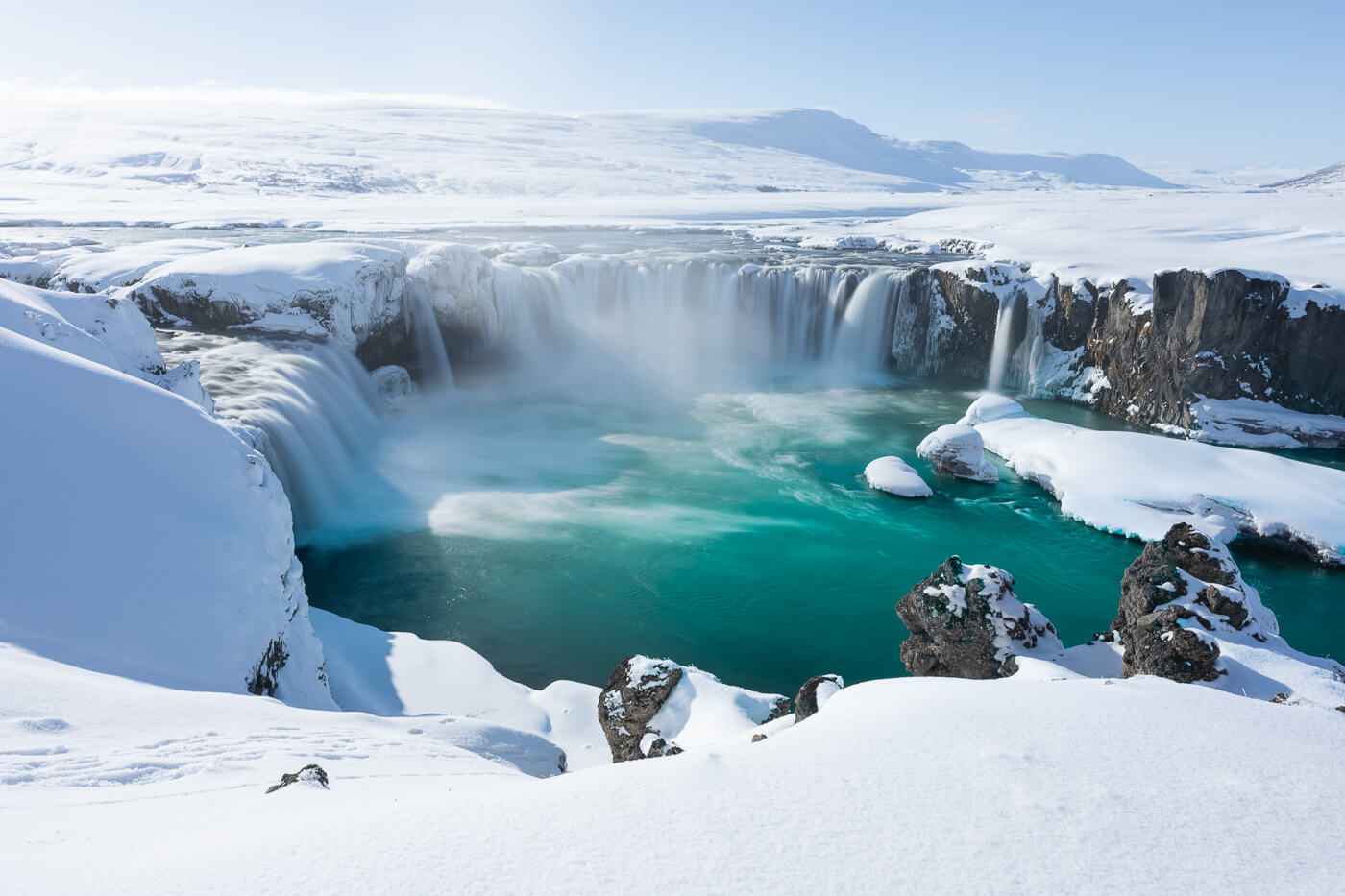
That’s the reason why I picked March for my eight days, winter trip itinerary. Due to the balance between daylight hours, which allows me to do day hikes and visit more places, and darkness, which allows me to catch the ephemeral Aurora Borealis, it was the perfect time of the year to view the magic, Icelandic winter landscape and do some outdoors activities.

Northern Lights dancing above a Van in Iceland.
If you are considering visiting Iceland in March – or just curious to see what it looks like, I’ll show plenty of photos of all the different conditions I came across so you can get an idea of what you may find.
I’ll also describe the challenges you may face in terms of driving and weather – and how you can try to make the most out of it.
Also, the itinerary is a mix of popular locations and lesser-known ones. And, while this was a winter itinerary, all of the locations are also suitable for any other time of the year. so you can use this post to plan your trip or visits to each location accordingly.
Lets’ go :).

Table of Contents
I structured the content in a way that would allow you to through all the steps of planning, but you can also use this table of contents to skip directly to any of the following sections:
Going to Iceland? Blue Car Rental Discount!
As a reader of The Photo Hikes, you get a 5% discount on your car rental when booking with Blue Car Rental through this website. The discount will be automatically applied to the booking through the following link
Driving the Iceland Ring Road in Winter – a Safety Note
Winter driving in Iceland is no joke, and you should take it very seriously. While Iceland is indeed a winter wonderland, there also are additional safety aspects you should take into account and plan for.
Winter Driving in Iceland can be a scary experience. Slippery roads, snow, and ice are serious risks for those not used to driving in winter conditions. Keep a close eye on road conditions at all times.
Even for those who are like myself, driving requires extreme carefulness and full focus on the road and road conditions. First tip: do rent a 4×4 or AWD car. It’s better to have the extra traction when you need it.

Winter driving conditions can vary a lot. From sudden closures to light snow or black ice all within short distances.
Winter storms in Iceland hit suddenly, are extreme, and last for a few days, stranding travelers wherever they are. Here’s another tip: keep at least a buffer of two to three days to get back to the airport! For instance, don’t plan to be in Akureyri on Sunday if you are flying out on Monday. If a storm hits and the ring road gets closed, what are you going to do?
In this case, you’d ideally want to be in Akureyri no later than Friday. Then, you’d likely have enough time for the storm to pass, for roads to reopen, and for you to make it to the airport. I used Akureyri as an example, but you get the gist of it.
Last but not least, always watch out for weather alerts multiple times a day on Vedur.is and check alerts on Safetravel.is too. Reconsider your trip in case of yellow warnings, and do not travel in case of orange warnings.
Choosing a Car for an Iceland Winter Trip
As mentioned, rent a 4×4 or AWD car. It’s better to have the extra traction than not when you need it. Some companies fit studded tires, while others are just winter tires. Choose the one you feel safest with.
If you are not used to winter driving conditions, go for a model with studded tires. Use a reliable, local company like Blue Car Rental. Their cars and mid-size SUVs are equipped with studded tires for the winter months. Also, if you are planning a trip, you get a 5% discount with Blue Car Rental booking via The Photo Hikes (read more here about our partnership with Blue Car Rental).
If you prefer a van, CampEasy is a great choice for 4WD vans. Lava Car Rental also has some cheaper ones available, but 2WD only.
Anyway, never be overconfident on the road because you have studded tires. Always drive with extreme care. Think of it as if you are driving on eggshells.

If you want a little more freedom and adventure, consider a camper. There are 4×4 campers available. I chose a van from CampEasy for this trip. I’ve used them a few times and always been happy. I do so because being outdoors 24/7 is a huge benefit when doing landscape photography. You’re always out there!

Camper and Campervans are also a good option if you prioritize enjoying the outdoors and seeing the northern lights.
In terms of campsites, while several campsites will be closed and inaccessible in winter, there will still be some that will be open. providing plenty of flexibility. Note that you can only camp at designated campsites in Iceland.
Don’t plan on using tents or rooftop tents unless you are experienced in camping in sub-zero temperatures. Pickups with cabins are usually heated, so those would work fine.
How to plan a Winter trip in Iceland
My best recommendation is to be as flexible as you can. This is even more important in the Icelandic winter. I appreciate that this may not be everyone’s style, but being flexible will allow you to travel to the places with the nicest weather and hopefully prevent you from being stuck in a storm.
But what does one stay flexible? This is how I do it, and I have followed this approach for over a decade now. I prepare a list of places I want to visit. Usually, more places than I’ll be able to visit.
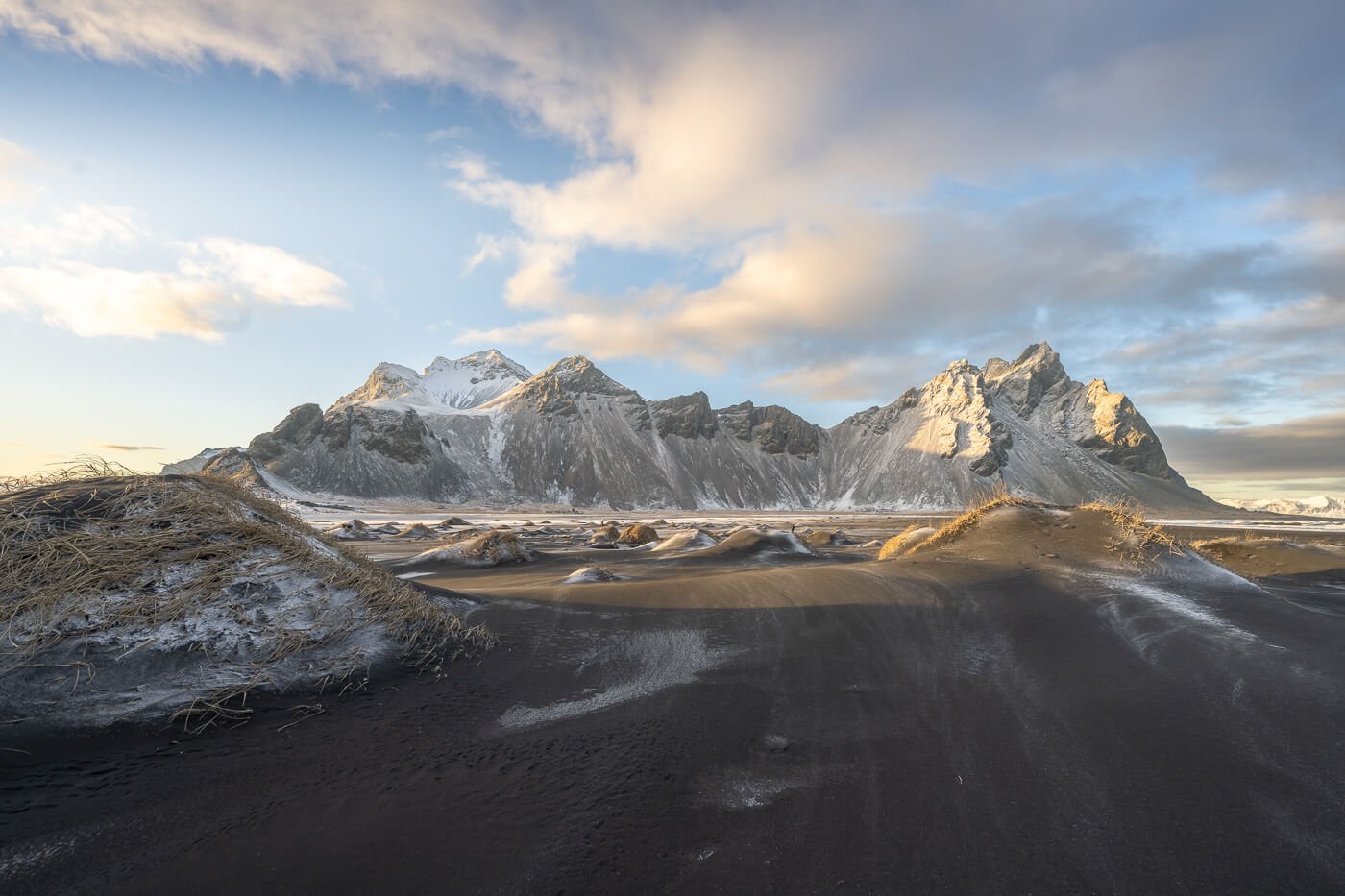
Do plan to visit landmarks and Iconic places, even all of them. That way you’ll have plenty of choice if the weather won’t allow you to visit some of them.
Then, I group locations by region. For instance, places I want to visit in South Iceland, West Iceland, the Snæfellsnes peninsula, and so on. Upon arrival, I then head first to where the best weather is, also considering the outlook for the following days, and so on for the following days, reviewing the itinerary according to the weather forecast.
That’s easy to do in a van – still possible to some extent in a car if you book refundable accommodations.
What to Pack for Iceland in Winter
Unless you’re coming from an even higher latitude than Iceland, you’ll find it a cold destination throughout the year. In winter, pack what I pack for every trip, minus the camping gear, plus some additional items like winter hiking trousers, one additional outer layer, and microspikes. Do bring a windproof layer.
You do not need crampons in Iceland in Winter unless you plan to go on glaciers or ice climbing, but even then, your tour guide will provide them for you. Microspikes will be more than fine for walking around and on regular hikes. This brings us to the next point.

Bringing the right gear to hike in cold temperatures is essential.
You may also want to pack some hand warmers if you are planning to stay out for long hours. Better to be overprepared than underprepared.
The main thing to keep in mind is: even if the temperature looks decent – let’s say in between 0-5°C (or 30- 40°F), it’s the wind that will make you cold. So, along with the temperature, check the wind speed forecast and chill factor. You want to be prepared for that, not just the temperature. The Icelandic wind can suck all the warmth out of you in no time.
Winter Hiking in Iceland – Tips and Safety
While Winter isn’t the best season to go hiking in Iceland, it is entirely possible to do that. Locations and choices are, of course, limited, but there are still plenty of them. The highlands will be off-limits at that time of the year, so it’s best to look for hikes around the ring road.
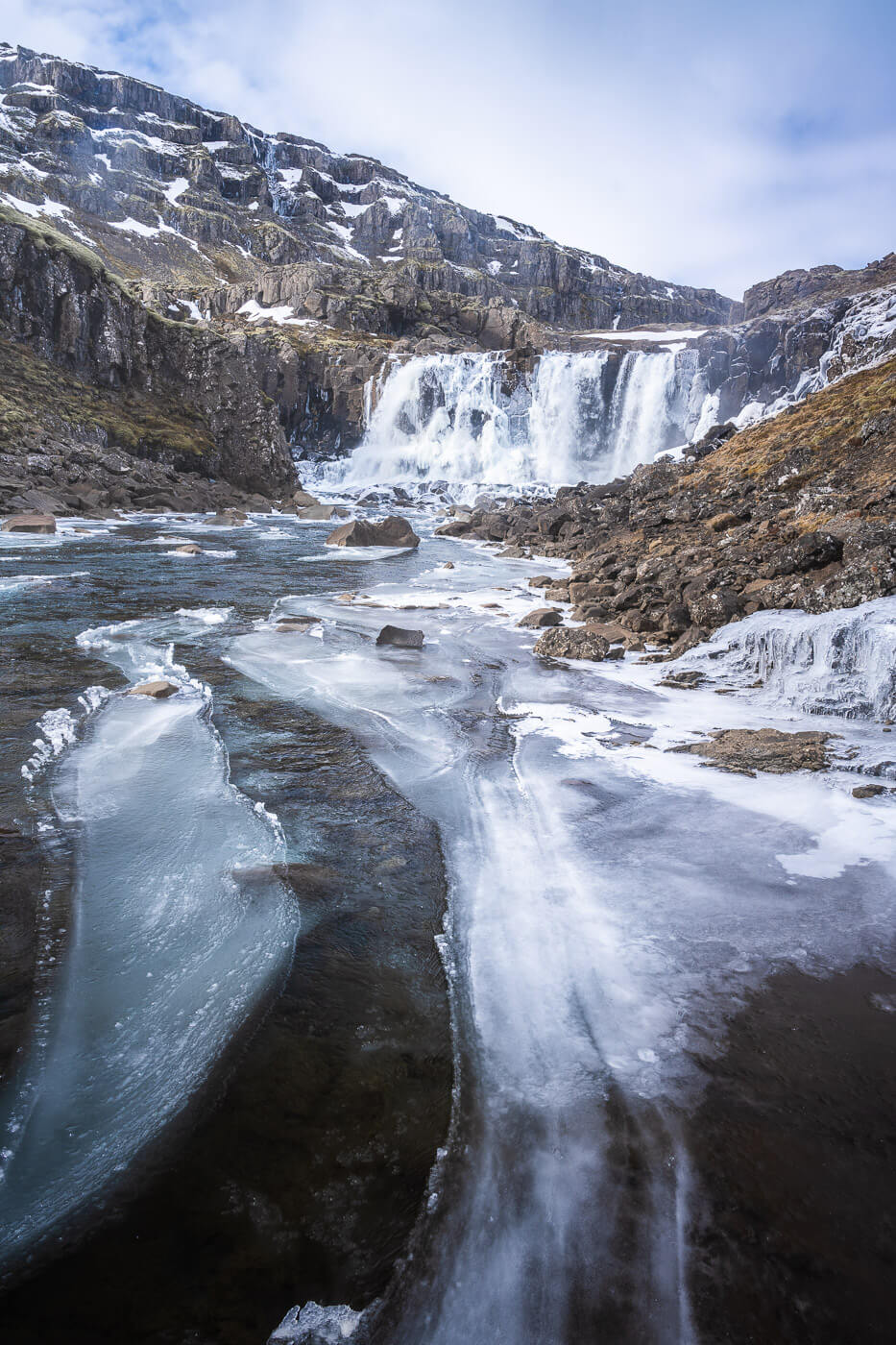
Iceland still offers plenty of amazing hiking choices, even in March. Here is Mulafoss, in the East.
In the itinerary I describe below, I will mention all the hikes I did, with a link to the hike report if you want to read more in detail. Some longer 10km-ish hikes are possible. It mostly depends on the weather and how much ice/snow there is at each location. But there’s plenty to choose from in a country like Iceland, with shorter and longer trails alike. As you will see, I even managed to do more than one hike per day, some days.
That’s where the “follow the weather” and “have a list of places” approach paid off. If you do that, versus having a fixed list or itinerary, you’ll be able to get the most out of your time. Granted, if a storm sweeps the country for three days, there’s not much you can do about it.
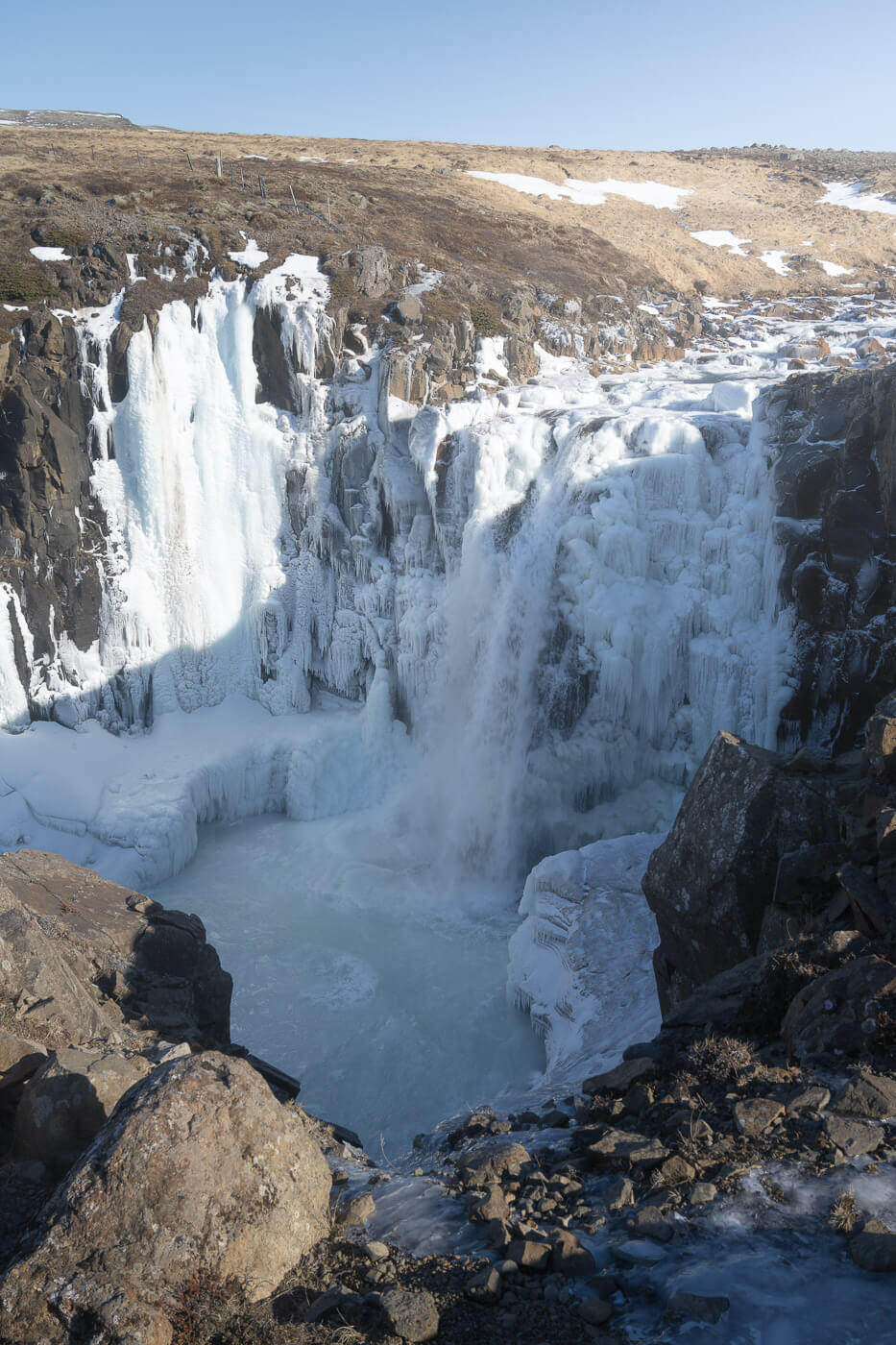
While the Ice is a nice addition to the landscape, it also poses serious dangers.
Hiking Safely
Again, a few other safety notes:
- Stay away from cliffs as much as possible, especially in case of snow and ice. Do not go anywhere near the edges. This applies to both above and below a cliff. Above it, you may not see spots of ice and slip on it. Similarly, in the case of snow, a ledge may have formed, and walking on it may cause it to collapse. Below it, the aforementioned snow ledges – or even icicles may fall. Rocks also. Frozen water increases in volume, so water in between rock cracks may cause rockfall.
- Similarly, don’t walk under or below waterfalls too close to the edge. Icicles and rocks may fall.
- If a trail is closed, it’s closed because it is unsafe to hike it. That’s it.
- Get back well before it gets dark – even with a headlamp, it is easy to miss spots of ice or holes in the ground when darkness starts to fall, and so does the temperature.
- If you travel solo, make sure someone knows where you are.
Always apply common sense, and respect the local signs and regulations.
Iceland Landscape Photography in March – Winter Landscapes and Northern Lights
While March isn’t the best month to go hiking in Iceland, it is a great one to catch the Northern Lights and do some landscape photography.
Sure, you won’t have access to the Highlands, but there are plenty of waterfalls, mountains, and glaciers all around the Islands. You won’t have the beautiful greens you have in summer, but you get the magic of the Snow and Ice.

Snow can create beautiful shapes in the landscape.
You don’t have the long days you have in summer, but the sun stays lower on the horizon throughout the day. The entire day is almost Golden Hour”, casting a warm light on the landscape. This creates beautiful scenes also outside of the usual tourist spots.

In March, the soft light often assumes epic or dramatic tones above a frozen landscape.

The sun is relatively low on the horizon too, casting some beautiful light for longer periods.
And again, you have the chance to catch the Aurora Borealis.
If you have already been to Iceland in summer, it is definitely worth visiting in winter, too, as the whole island will be transformed into an entirely different world.
Iceland Ring Road – 8 days Itinerary in March
Here, you’ll find the full itinerary for my 8-day trip, including stops. I drove the entire ring road, plus a visit to the Snæfellsnes. It’s quite rare to be able to do it in winter, especially in such a short timeframe, especially because of the weather and possible road closures.

Snow can cover the landscape on short notice. Try to time your drive after a snowfall, and you’ll get a view of a magic winter landscape.
I both got lucky and optimized my chances by using the “follow the weather” approach. That essentially means driving to where the nice weather is. You end up driving a lot with this approach, but you also end up maximizing your outdoor time.
So one more tip for you: try to stay flexible, check the weather forecast multiple times a day, and try to follow the best weather. Or stay where the best weather is, if storms hit elsewhere in the country. If you are not in a van, try to book refundable accommodations, so you can cancel and replan as needed. Or book on the go.
Anyway, here is my full, eight-day Itinerary with stops. It’s a mix of popular and lesser-known locations. Having been to Iceland countless times, I always add some new, off-the-beaten-path locations on each trip. This was no exception:
- Day 1: Seljalandsfoss – slept at Skogafoss campsite
- Day 2: Hatta, Systrafoss, Vestrahorn – Slept at the Vestrahorn campsite
- Day 3: Fossárdalur and Mulafoss, Beljandi, Gilsárfoss, Búðarárfoss – Slept at Egilsstaðir campsite
- Day 4: Namafjall Geothermal Area, Godafoss. Tried to get to Alderyarfoss but could not – Slept at the Akureyri Campsite
- Day 5: Benefoss, Attifoss, Rauðgil, Arnarstapi coastal trail, Lóndrangar – Slept on the Snaefelssness campsite
- Day 6: Helgufoss, Reykjadalur, Dyrholaey – slept at the (closed) Vik Campsite
- Day 7: Gufufoss, Skaftafell glacier – Slept at Skaftafell Campsite
- Day 8: Drove back to Reykjavik, spent the night walking around town, waiting to return the camper at 4 AM
For each day, I will also add possible hiking alternatives. These will also highly depend on snow and ice conditions, so look into that before heading out. Now let’s get into the details, distances, driving time, and locations of each day.

Day 1: Seljalandsfoss – Northern Lights and Waterfalls
Driving Distance: 190 KM / Drive Time: 2:45 hours
Straight out of the airport, I went for some groceries (here, which I’d recommend) and headed to where the clear skies were. I had to choose a location for the evening and went for Seljalandsfoss, hoping for a decent sunset and some northern lights.

Seljalandsfoss in Winter.
Seljalandsfoss and Gljufrabui, are alwasy great to see. I did not really have a good sunset, but I did catch some very nice northern lights.
Right after sunset, I went back to the van to eat my dinner, and as soon as I had finished I saw a faint glow in the sky. It was still twilight, which is why I always recommend being out from sunset when chasing the lights.

Northern Lights above Seljalandsfoss.
We had a great display for about half an hour. Quite an awesome start to the trip!
I then spent the night at the Skogafoss campsite, a short drive away. The idea was to drive further east, assuming the weather looked good in that part of the country.
Hiking alternatives to look into: Skogafoss Waterfall Way, Reynisfjall.
Day 2: Hatta Hike in Vik, Systrafoss, Vestrahorn – Great Hiking and Northern Lights again
Driving Distance: 352 / Drive Time: 4:45
The second day was amazing too, and the forecast looked good for most of the day toward the east, while a storm was hitting the north and the north-west part of the country.
Fair weather for the whole day, with some strong winds hitting the east in the evening. I can work with that as long as it does not rain – and for the time being there was no rain in the forecast.
Plenty of hiking and again, northern Lights in the evening, at a location that could not be better – Vestrahorn. These were the last lights I was on my trip, but seeing them twice on an eight-day trip is quite good actually.
The day started with the first real hike of this trip. A hike I had been wanting to do for quite a few years now. It’s the hike to Hatta, a mountain above the town of Vik in south Iceland. The hike took less than three hours, saw some snow and amazing views.

View of Vik from the Hiking trail to Hatta, a 2/2:30 hours out-and-back hike.
Next, I drove further east and stopped at Systrafoss for another short hike. In a little over an hour you can hike to the top of the waterfall. A nice hike with views as far as the eye can see on a clear day.
The view of the waterfall is better from below, but you can hike to the top of the rock above it.
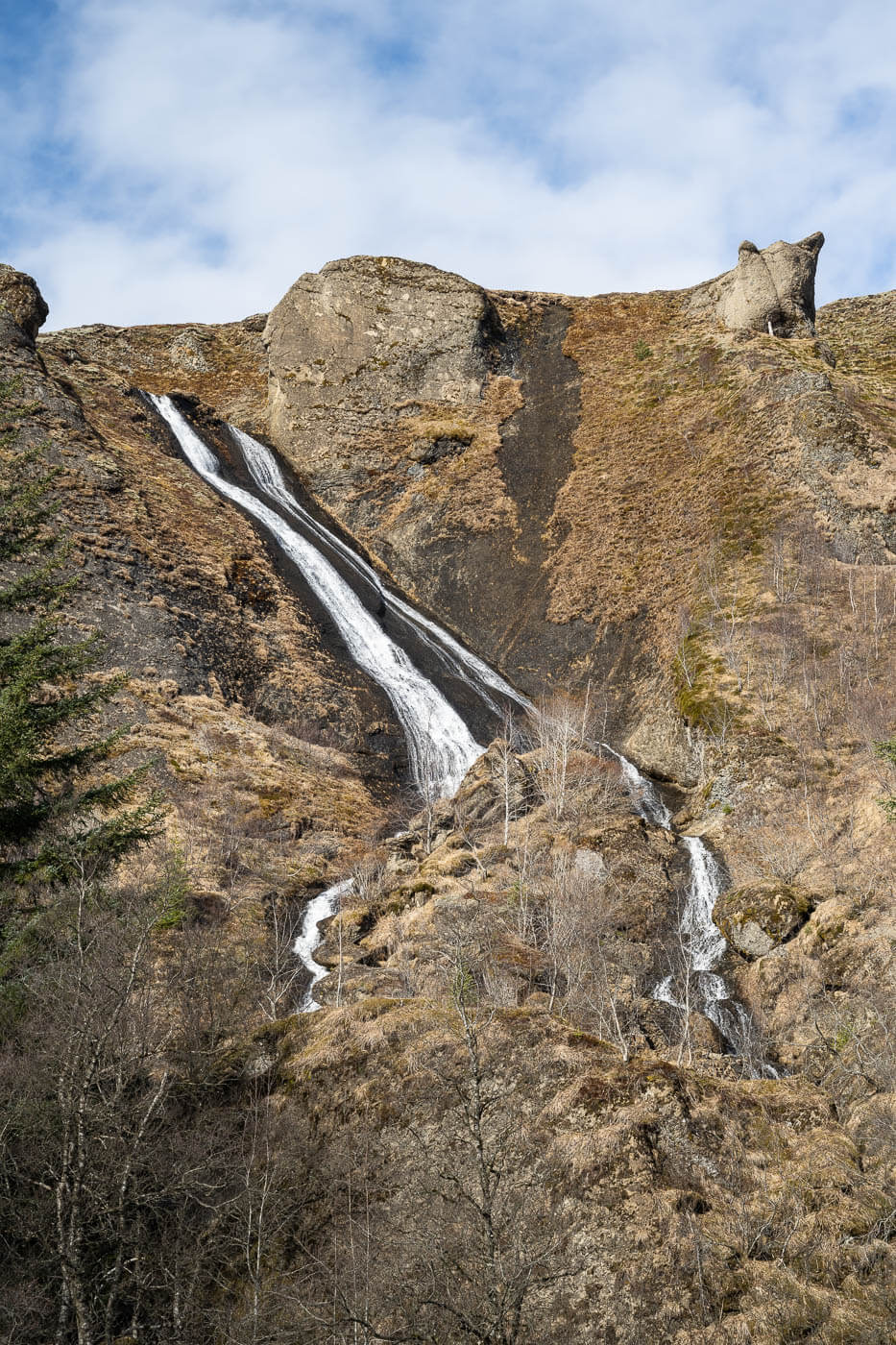
Systrafoss.
Then onto the next stop – Vestrahorn, with an in-between stop at Jökulsárlón. While I visited the Glacier Lagoon several times before, it’s rarely saw it under clear skies. So that was definitely worth a stop.

Jokulsarlon in March.
I had planned to be at Vestrahorn for sunset and to catch the northern lights. The skies were mostly clear, with strong winds and freezing temperatures forecasted.
So it was looking good – and it did.

Sunset at Vestrahorn.

Northern Lights later that evening.
Again, the light appeared during the twilight, so I went out in the wind with all the layers I had. The wind blew really hard, and I could feel the pain of the black sand and ice crystals hitting my face in 60km/h winds, with stronger gusts.
Anyway, there was a great display for about 15-20 minutes, enough to capture some more photos.
Hiking alternatives to look into: Fjaðrárgljúfur, Svartifoss.
Day 3: Fossárdalur and Mulafoss, Beljandi, Gilsárfoss, Búðarárfoss – Frozen Waterfalls and a Long drive
Driving Distance: 315 KM / Drive Time: 5:20 Hours
Another great day of Hiking, with plenty of locations visited, mostly lesser-known but still beautiful locations. The weather was looking good for most of the day across the island, but bad weather and snowfall were forecasted for the late afternoon.
With the forecast improving to the north for the following days and the weather getting worse in the south, I decided to head further north. So after a good night’s sleep at the Vestrahorn campsite – and a shower to remove all the sand the wind blew all the way into my underwear somehow, I set out for another day of winter hikes.
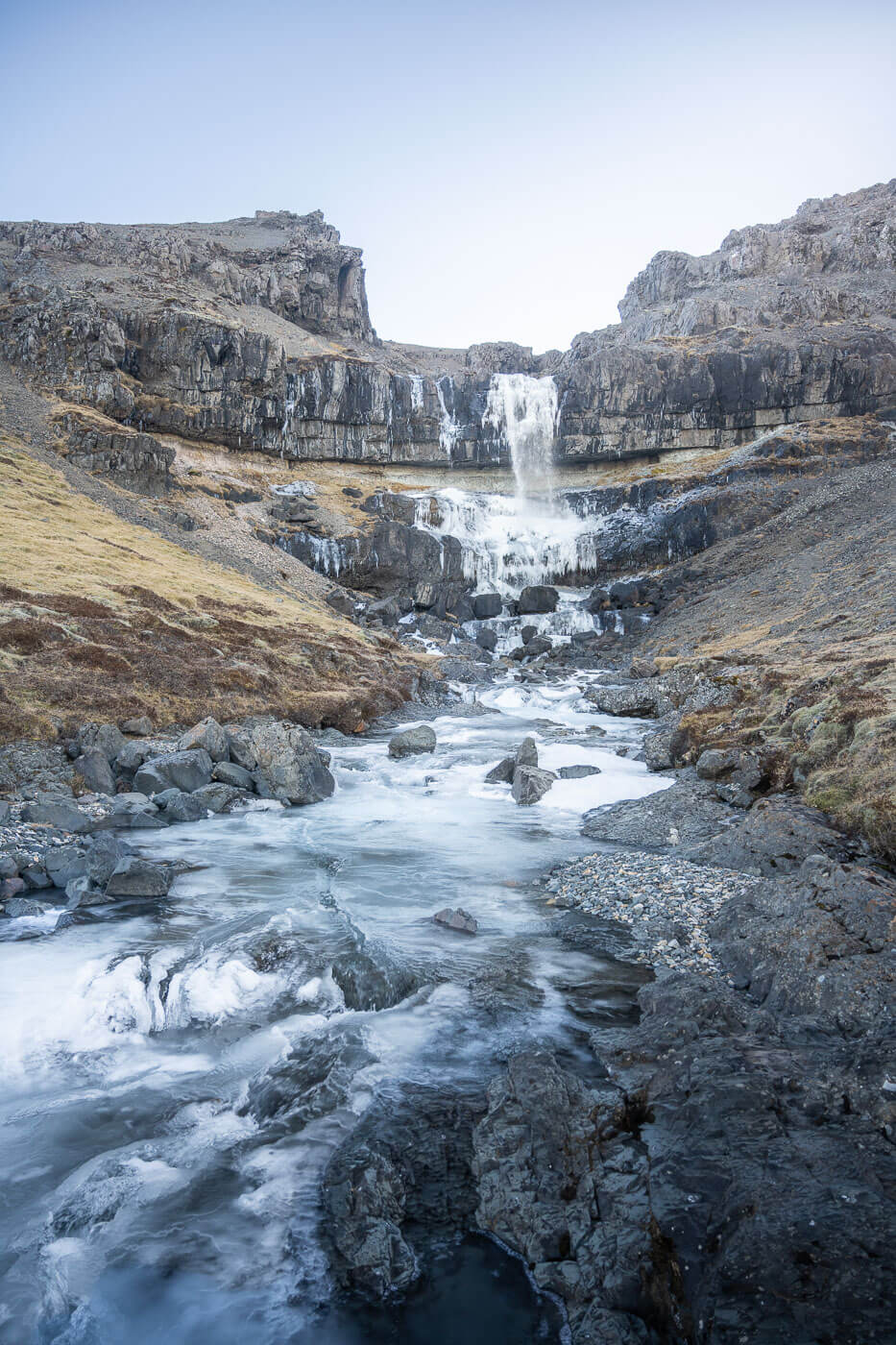
Bergarfoss (East Iceland).
Before driving further North, I visited a waterfall near Höfn, Bergárfoss. You can drive very close to it, as there is a power plant close to the waterfall. The road is rough, but doable in normal cars.
I then drove further north again, to do a hike I had xoverlooked for a very long time. It’s the Fossárdalur waterfalls hike, in east Iceland. It’s an out-and-back trail where you’ll see several waterfalls. I even saw a herd of reindeer.
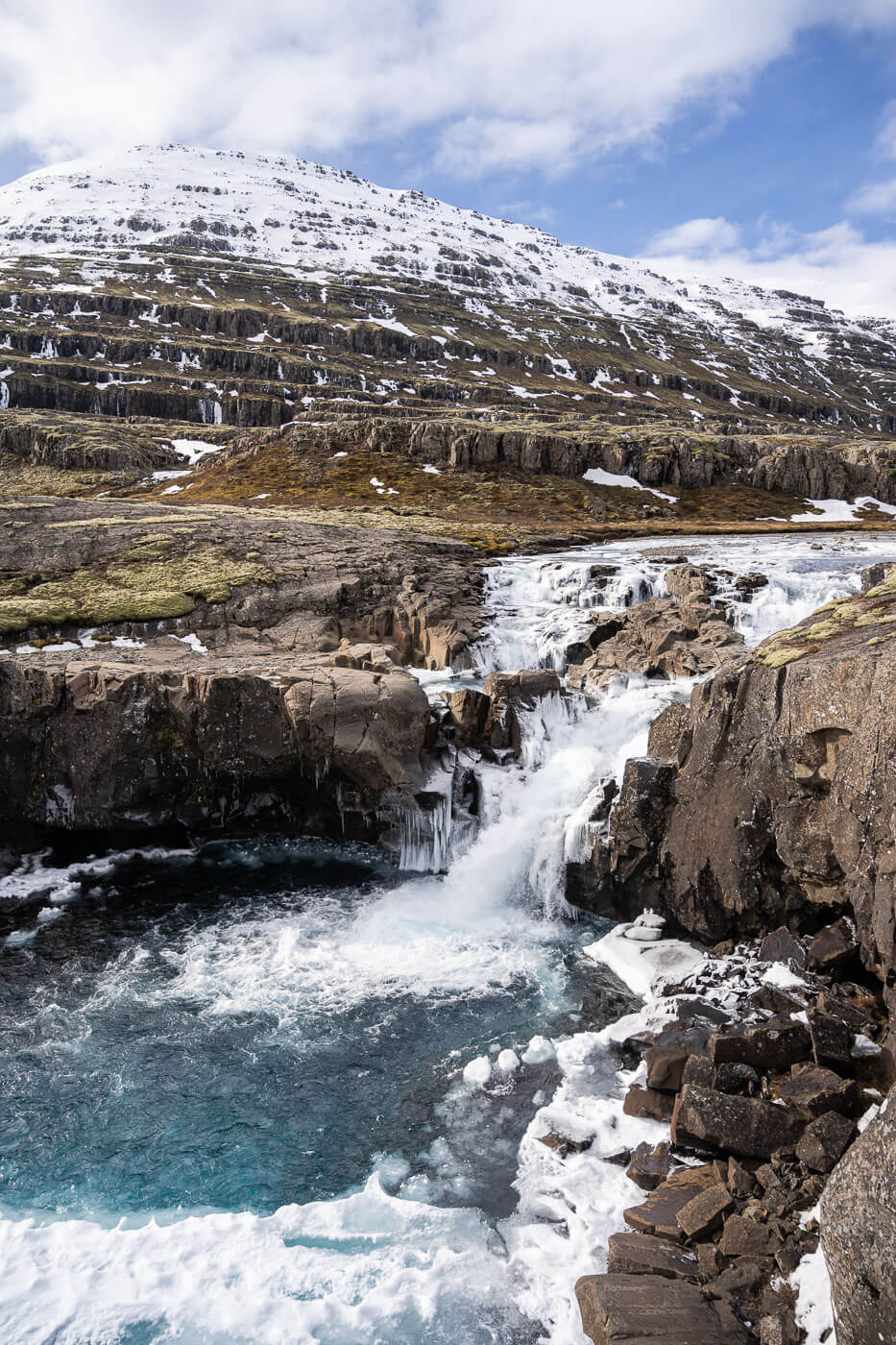
Waterfall on the Fossardalur Hiking Trail to Mulafoss.

Then I visited a few more shorter hiking trails (and waterfalls) in the east. First, Beljandi, a nice waterfall off the beaten path. Then I hiked to another beautiful waterfall, Gilsárfoss. it’s a short 15-20-minute hike (one way) to a beautiful, hidden waterfall.
Last, one more waterfall, Búðarárfoss where there also is a small canyon. It’s a beautiful place, and I could not do it justice with the photos.

Baljandi.

Gilsárfoss.

Budarfoss
I slept at the Egilsstaðir campsite. It was already snowing when I arrived, and it kept snowing for the whole night, with the weather clearing up in the early morning.
Hiking alternatives to look into: Stuðlagil, Hengifoss.
Day 4: Namafjall Geothermal Area, Godafoss, tried to get to Alderyarfoss but could not – A day in the Snowy North
Driving Distance: 323 KM / Drive Time: 4:45
A lot of driving on the fourth day, and less hiking. I did not have as much time as I hoped for in the north, but I had to drive through in between storms. The weather did look good in the north for that day, less so the following ones – but then it was looking better in the West, so my itinerary was laid out.
Due to the amount of snow in the north, I could not do all the hiking I had planned. First, I had planned to hike to the top of Namafjall, above the geothermal area. That would have probably required snowshoes, but the geothermal area was fully walkable.
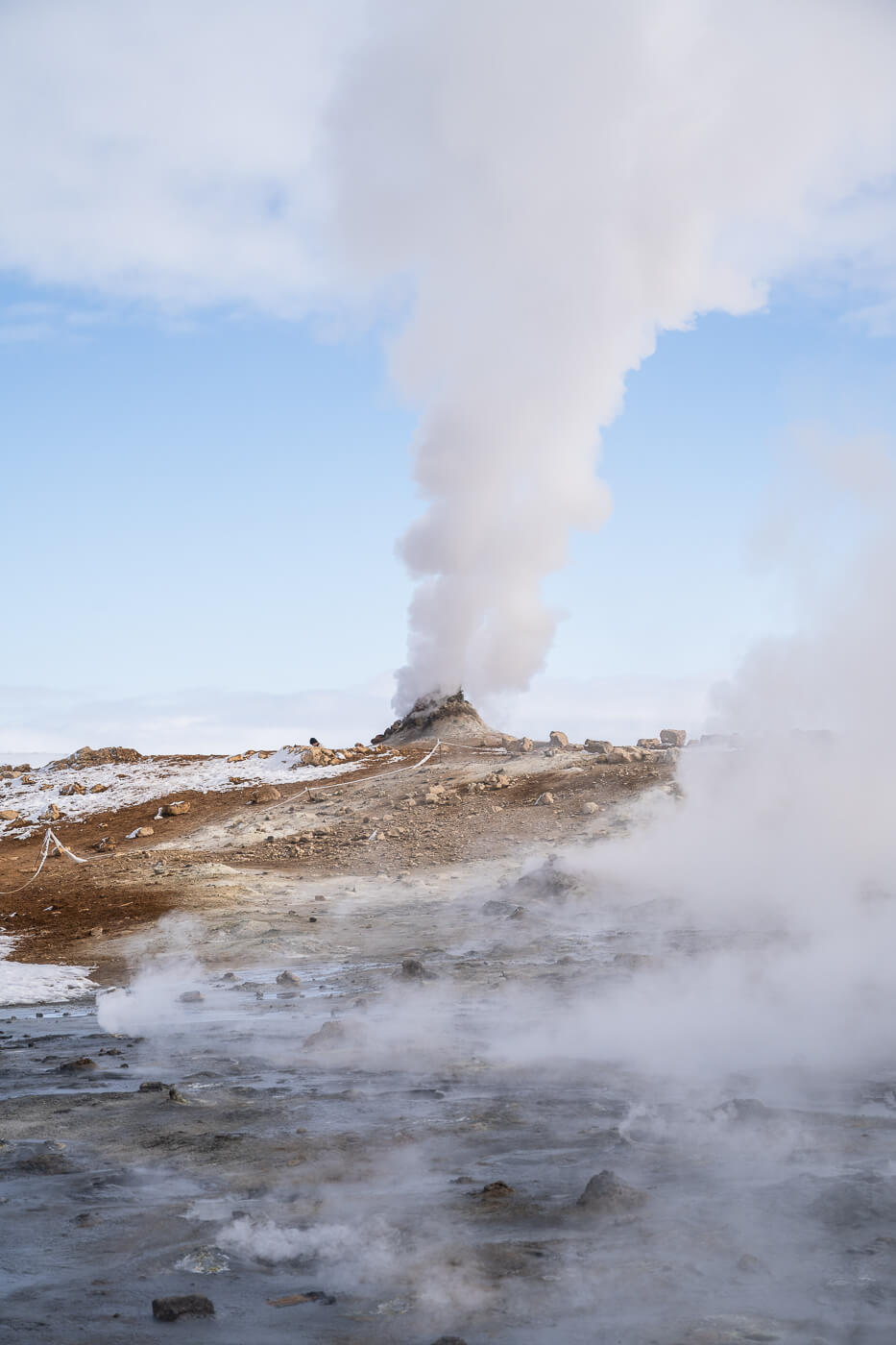
Namafjall Geothermal Area.
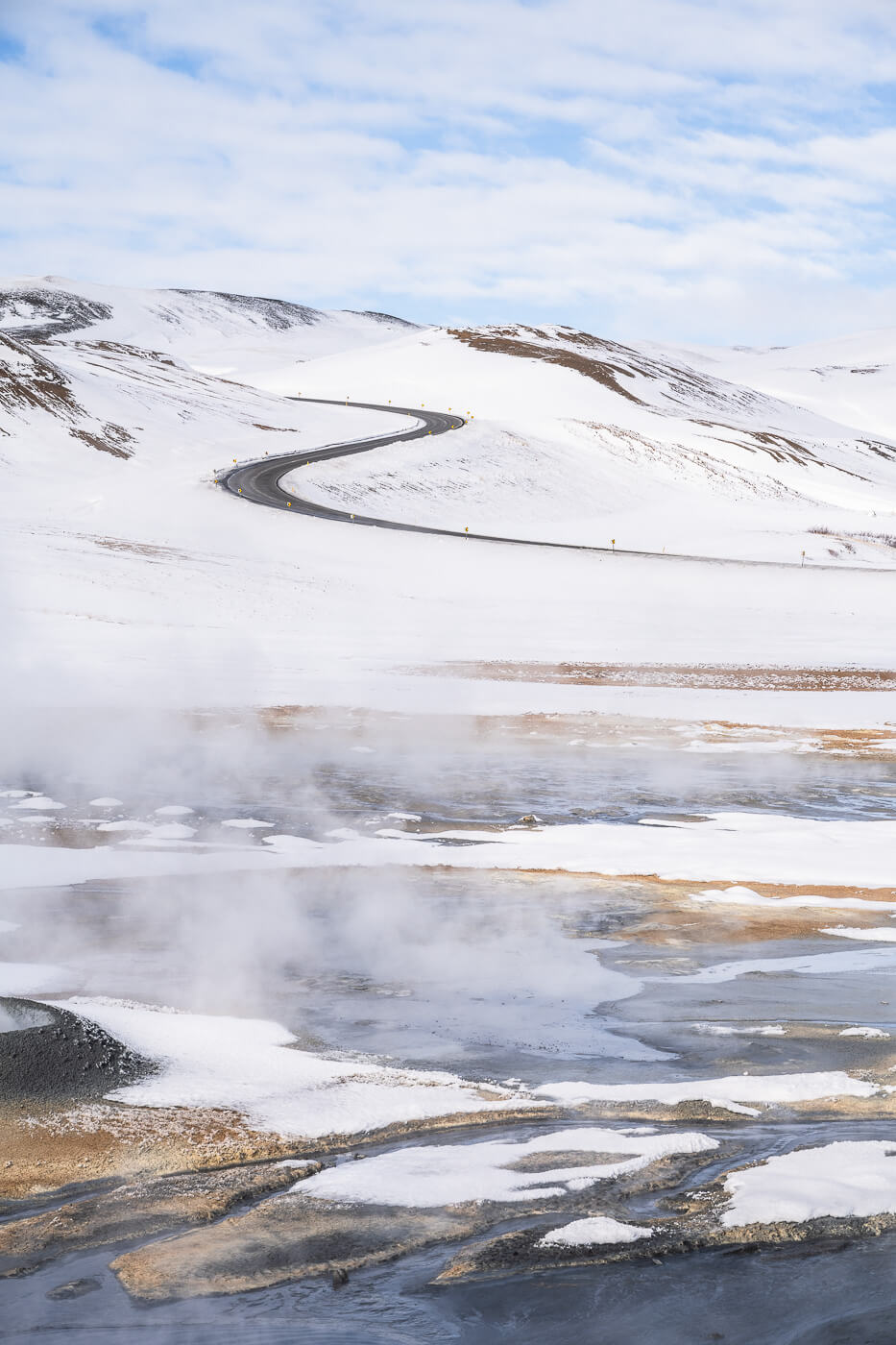
Then, onto the next stop.
One of my must-stop locations was Godafoss, which I visited next. I had been there several times before, but never in winter, and I really wanted to catch it in its “winter suit”. It definitely did not disappoint.

Godafoss in Winter.
Then what I thought could have been the highlight of the day: the hike to Alderyarfoss. While the F-road was closed, it is technically possible to drive to the end of the regular road and walk from there. There also are several winter superjeep tours to this location. So off I want, hoping to reach the end of the regular road and hike the last few KMs from there.
Unfortunately, that wasn’t the case. While I managed to drive almost all the way to the end of the regular road in my 4×4 van, conditions were too slippery. I had three close calls with the ditch before I decided to turn back. Conditions were extremely slippery, and it was not worth risking it any further and compromising the rest of the vacation.

Somewhere near Akureyri.
Too bad, but I prefer to have more days to look forward to than having to wait for rescue. So I went to Akureyri for dinner first, then to the campsite.
Hiking alternatives to look into: Hverfjall, Dettifoss, and Selfoss.
Day 5: Benefoss, Attifoss, Rauðgil, Arnarstapi, Lóndrangar – A long day of driving to escape a storm in the North
Driving Distance: 600 KM / Drive Time: 8:15 Hours
By far the longest day on the road, but also with lots of hiking. Looking at the weather forecast, all good in West Iceland. that meant plenty of choices to wander around.
I first attempted to visit three little-known waterfalls in the West; Benefoss, Ankafoss, and Attifoss. I did not have much luck here because of the snow depth and snow covering a small creek. So I pretty much just got to the first waterfall.

A hut on the Benefoss, Ankafoss and Attifoss waterfalls trail.

Benefoss in Winter.
Next, I visited another little-known location, Rauðgil. Yet another rather amazing discovery. A big ravine with several waterfalls.
It’s quite a relatively long hike that took a couple of hours. This really is a hidden gem. If you are looking for a nice hike away from the major attractions, this may be for you.

The last waterfall on the Rauðgil trail.
Last, I drove to the Snaefelsness peninsula because the weather forecast promised clear skies at night. With some extra time to spare, I hiked the short coastal trail in Arnarstapi.
This is a hiking trail that can easily be done in winter, and especially in March, even after a light snowfall. Plenty of landmarks to see.
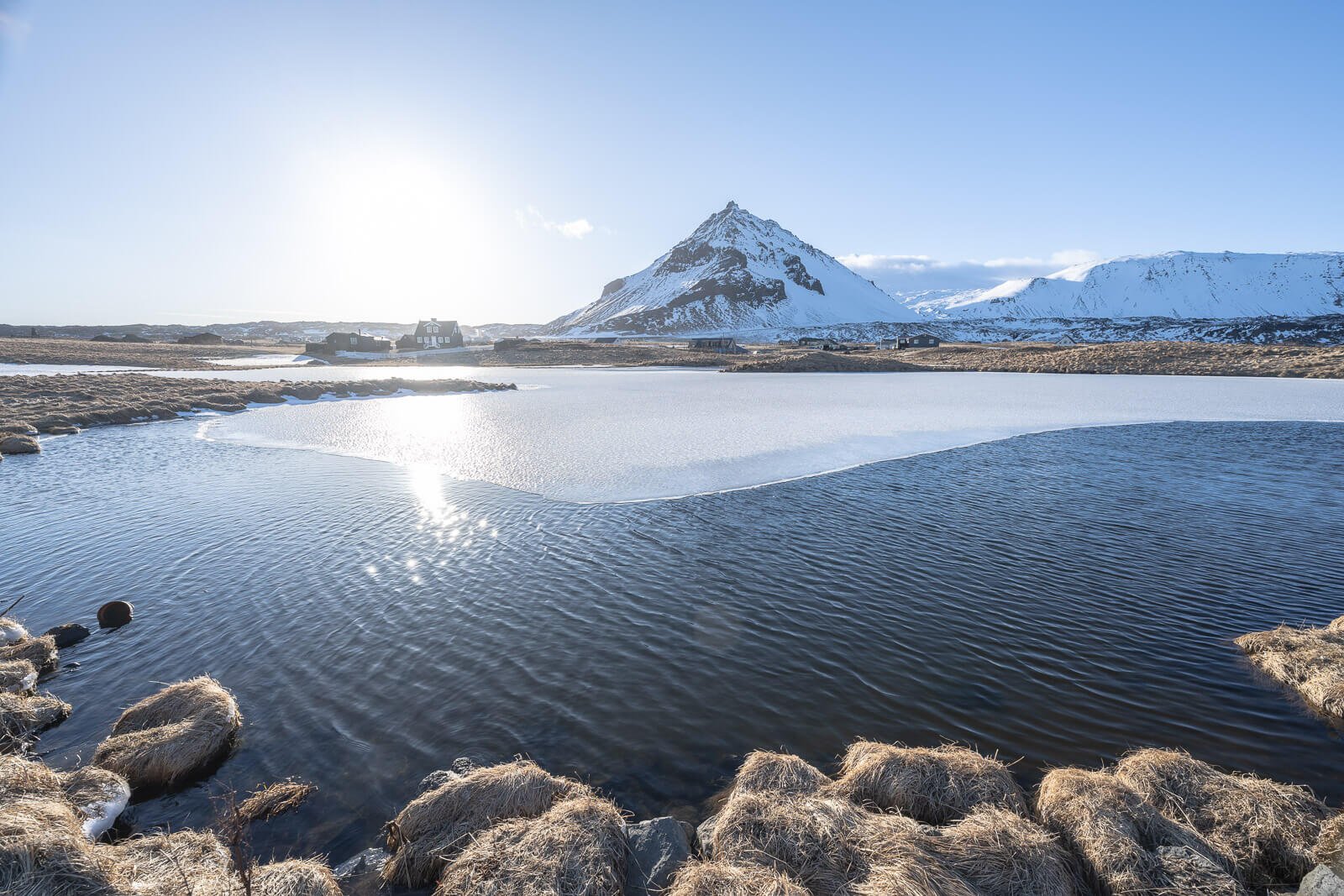
Stapafell, the mountain in the background.

The “House” in Hellnar

Gatklettur.
Then I drove to Lóndrangar for sunset – which did not disappoint. There’s a short hiking trail that leads to a viewpoint above the cliffs, and another one that leads next to them.
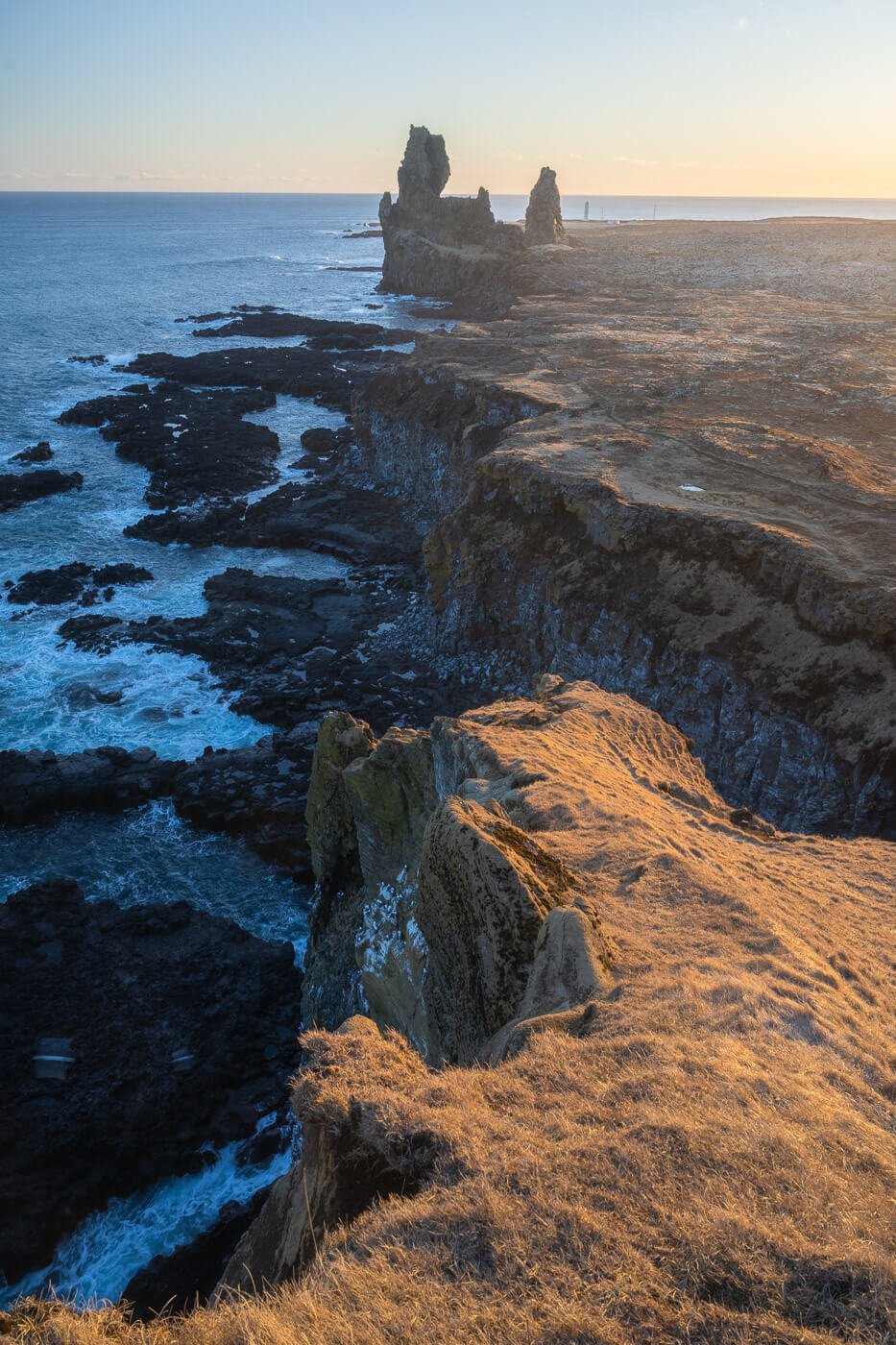
Lóndrangar.
I stayed up until not very late due to how tired I was after all the driving and hiking. I arrived at the Snorrastadir Farm Holidays late at night, but I did not catch any lights. However, I did sleep like a stone.
Hiking Alternatives to look into: Bolugil, Reykjafoss, Kolugljufur.
Day 6: Helgufoss, Reykjadalur, Dyrhólaey – Warmer South Coast
Driving Distance: 320 KM / Drive Time: 5:00
The next day, the path was set with nice weather in the south ofcally, the west was still sunny, Iceland. Techni too, but the forecast announced extreme winds. So south it was.
I drove through the Thingvellir National Park and stopped for a short hike to Helgufoss, a small waterfall accessible via Road 36. It’s a short hike, about 40 minutes max.
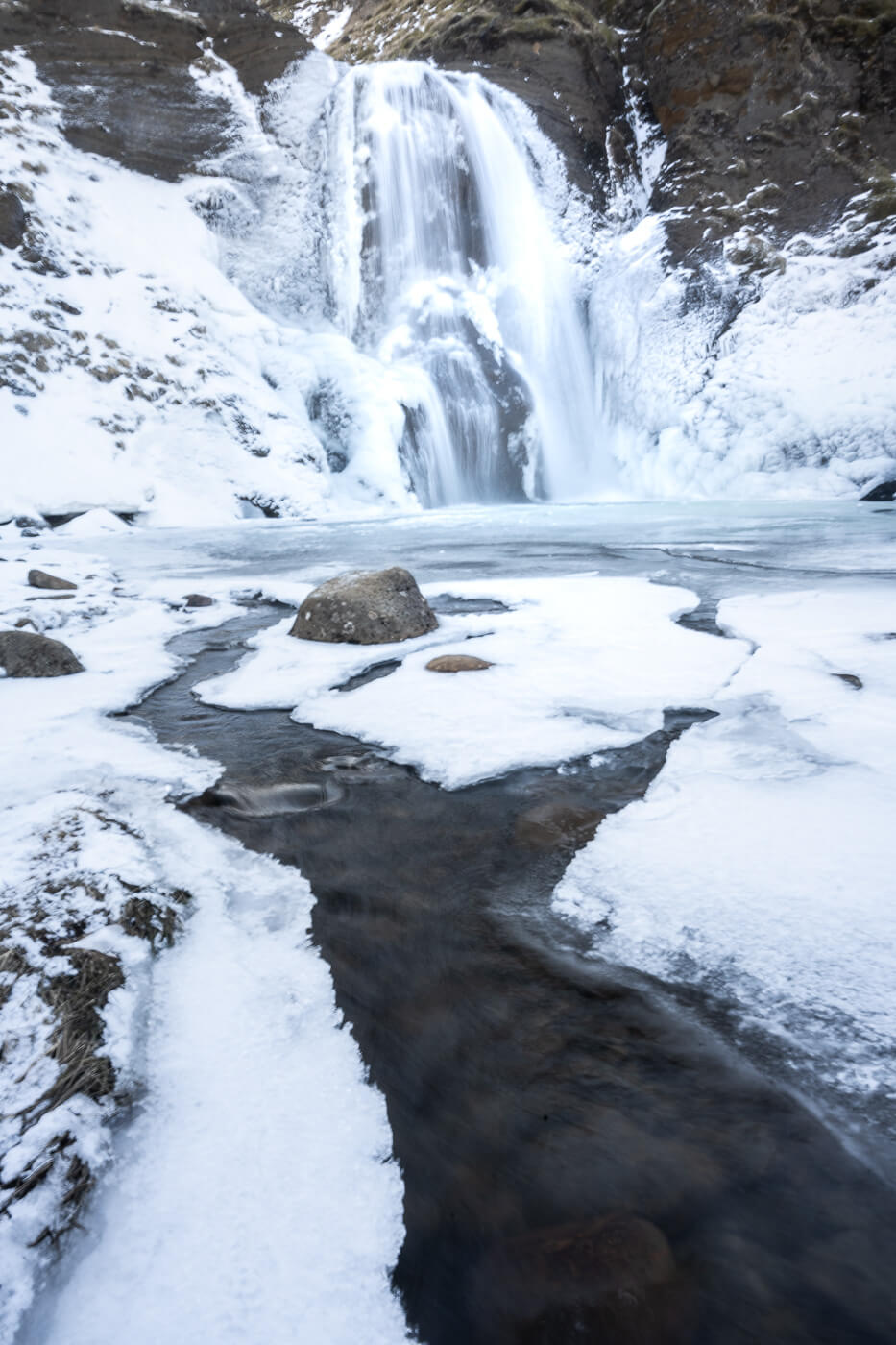
Helgufoss.
After that, I continued toward the south. The plan was to hike to Reykjadalur Hot Springs. I arrived there after lunch and hiked up the trail to the hot springs in little over an hour. Beautiful landscape along the trail. Of course, the great reward is a dip in the hot waters of the geothermal river.
However, I opted to hike past the bathing point and hiked the loop around the geothermal area. It was entirely doable despite the snow.

Reykjadalur river baths.
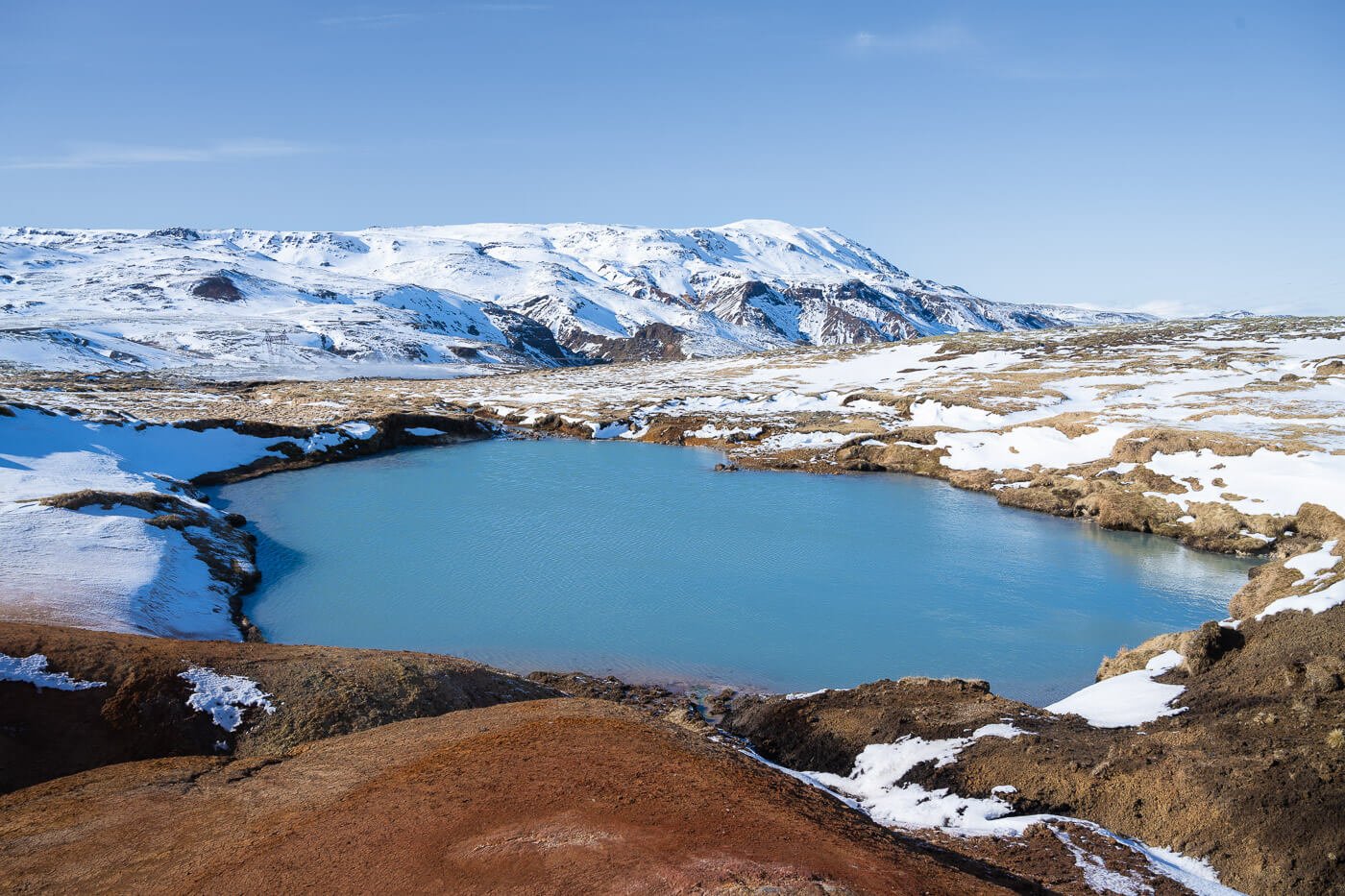
Geothermal pool on the loop around the Geothermal Area.

Despite the snow, several of the geothermal features and fumaroles were visible, revealing the beautiful colors of the soil.
I then went to Dyrhólaey for sunset, which wasn’t epic, but not bad either. It’s such a spectacular location that it’s worth a stop in (almost) any weather.
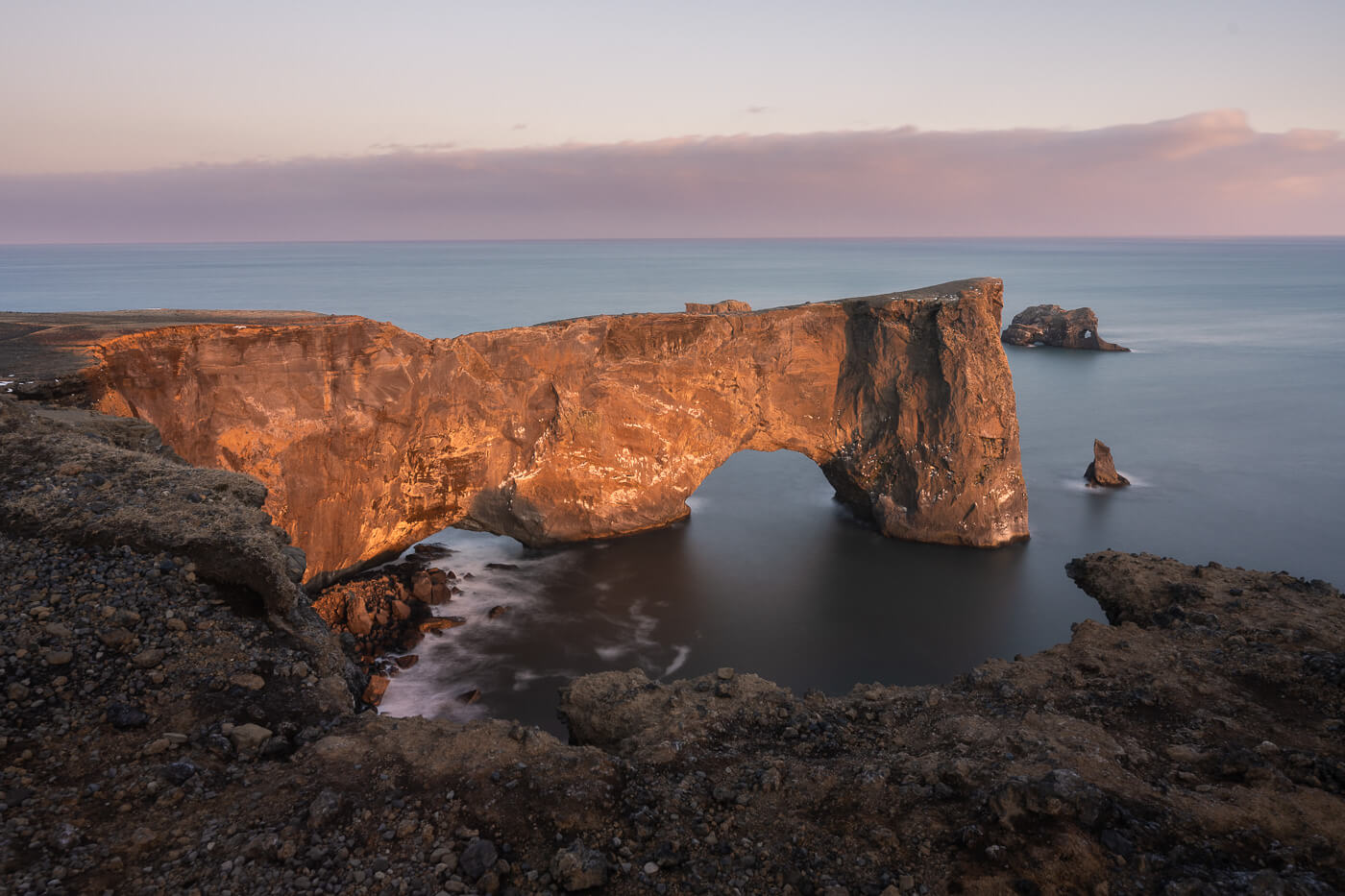
Dyrholahey.

Sunset at Dyrholaey
There aren’t open campsites in the area. The only one is Vik’s but it is technically closed. Despite that, it seems tolerated for Campers/Campervans to spend the night there. There’s no access to any of the facilities, but at least it is like a parking spot where you can spend the night.
Hiking Alternatives: Öxarárfoss, Seljalandsfoss and Gljufrabui.
Day 7: Gufufoss, Virkisjökull – More nice weather in the East.
Driving Distance: 145 KM / Drive Time: 2:15 Hours
Again further east to the nicest weather I could find. Against my better judgment of driving further east to drive back again the next day, I drove all the way to Skafatafell. Again, amazing weather there, so off I went.
The first stop on that day was yet another little-known location, close to Lomagnupur. It’s a hike up the Djúpá River, where you can see two beautiful Waterfalls, Bassi and Gufufoss.

Gufufoss, a waterfall on the Djupa river hiking trail.

Another view of Gufufoss.
This was more or less a random hike into unknown territory. I know there was some sort of trail there, but that’s it. I am glad I did, and that was a good reward for yet another long drive.
This hike took about an hour, and I still had plenty of time left to explore some more. So I took the opportunity to drive to the Skaftafell part and explore a side of the glacier I had never visited, Virkisjökull.
This location is not signposted, but tour companies heavily use it for glacier walks. You should not venture on the glacier by yourself for safety reasons, but there’s plenty to see. without doing that.

Virkisjökull

The road is rough, but you can drive to the parking area in any regular car. Just be careful, and remember no off-road driving.
Hiking Alternatives: Other than what I already mentioned, I can also recommend the short hike to Svínafellsjökull.
Day 8: Leisure drive back to Reykjavik – Hanging around town all night
Driving Distance: 385 KM / Drive Time: 5:30 Hours
It’s a tradition for me to spend the last day in Iceland for a walk, some food, and a few beers in town. It’s a lively city, where nightlife starts late, and there are plenty of nice bars, restaurants, or pubs to go for some food, a drink, or craft beers. Or all of them :)
So no hiking, no cameras on that day, just some classic tourist strolls in town. I personally find this a nice way to decompress after long days and nights on the road.
Conclusion and Final Tips for a March Winter Hiking trip and Northern Lights chasing in Iceland
As you can see, this was quite an amazing trip, even without going into the highlands. Iceland in winter can be wild, and it surely is magic, with the snow, the sun low on the horizon, the ice, and the Aurora Borealis.
Hopefully, you now have a good idea of how Iceland can look in winter and especially in March, how much hiking you could do and where, and what to expect in terms of northern lights for your own trip.
If you are attempting to do the ring road in winter, don’t count on being able to do it in less than two weeks. However, plan for a list of places you want to visit, stay flexible, and see where the best weather takes you during your stay.
Be prepared for the coldest weather. Remember, better overprepared than underprepared.
If you have any questions about the content or want to share your tips and experiences, feel free to do so in the comments sections below.
Last but not least, stay safe – and you’ll have a blast!
Additional Resources
- Check out more Hikes in Iceland (with maps) here.
- More Itineraries – read about an Eight days Campervan Trip in May.
- Also, read the SafeTravel page about winter driving in Iceland
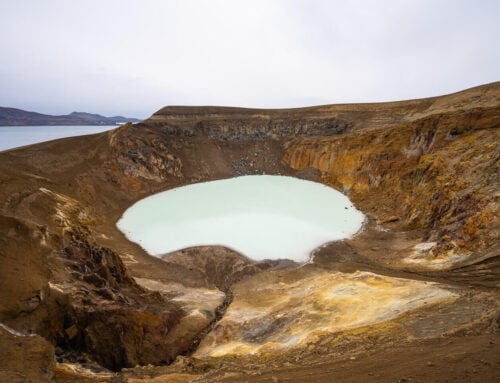
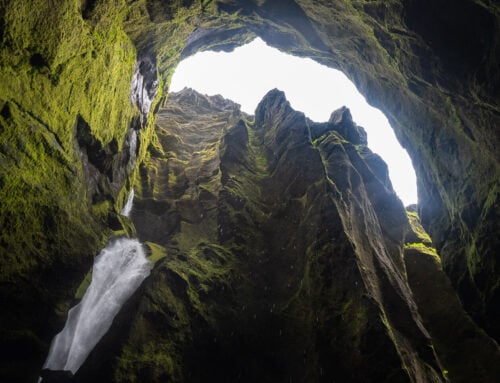
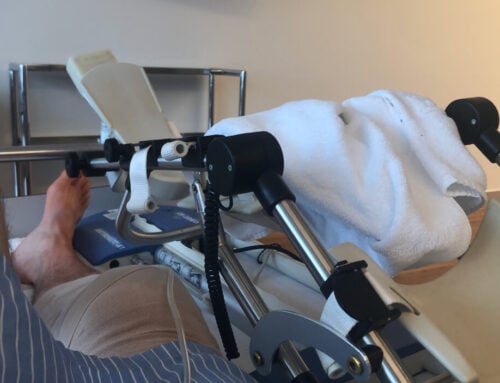
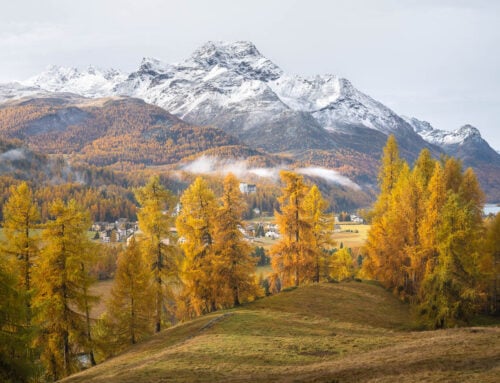
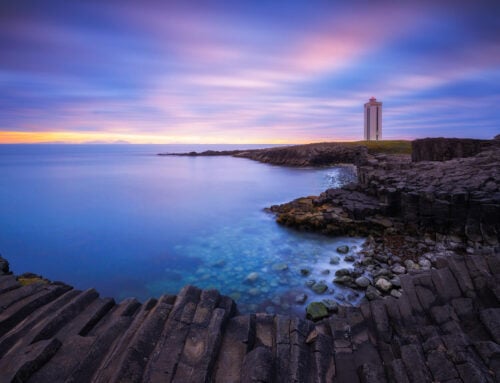

Leave A Comment